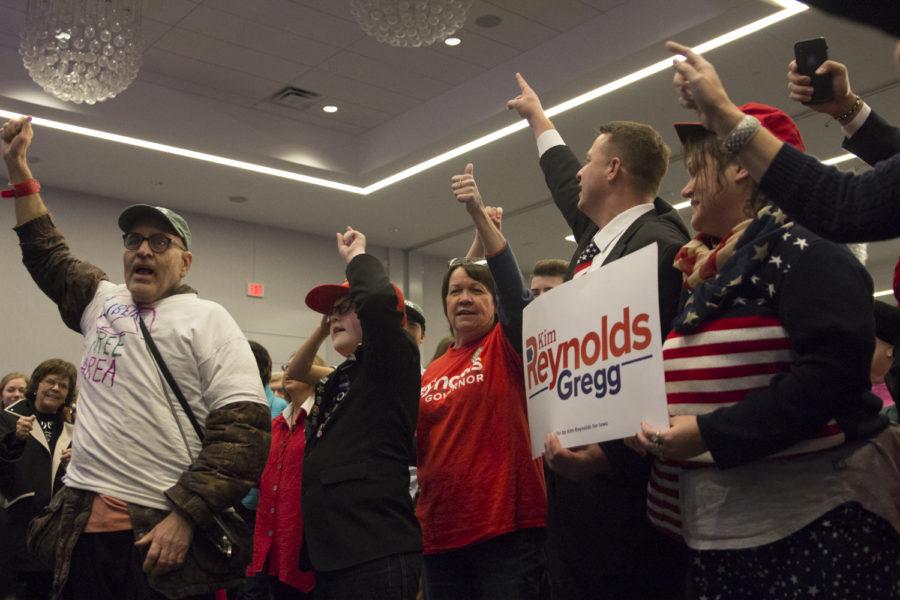Midterms: ‘Blue wave’ thwarted by ‘red wall’ nationwide
Kennedy DeRaedt/Iowa State Daily
Mike Naig, Republican candidate for Iowa Secretary of Agriculture and Kim Reynolds, Republican candidate for Iowa governor host an “Iowa GOP Victory Party” on Nov. 6 at the Hilton in downtown Des Moines.
November 7, 2018
A so-called “blue wave” was expected to sweep across this year’s midterm elections, but some experts say that the “blue wave” hit a “red wall.”
In order to create a “blue wave,” the Democrats needed to flip 2 seats to take control of the Senate and at least 32 of the Republican-held seats in the House to take the 218 total seats needed for a majority.
Republicans maintained control of the Senate with at least 51 held seats, but the Democrats reached 218 seats, which gained them control of the House.
According to David Andersen, a professor of political science at Iowa State, the blue wave was much more prevalent in Iowa and the Midwest than it was on the East Coast.
“I think a lot of people did exaggerate the extent that the blue wave would hit,” said Andersen. “It seems like in some areas of the country, and in particular the Midwest — the Midwest was absolutely vital for Trump’s victory in 2016—really seems to be returning to the Democratic party this year.”
Iowa’s elections were close, with Republican Kim Reynolds retaining her position as governor. At a congressional level, Steve King was re-elected to the 4th District, Democrat Dave Loebsack retained the 2nd District, Democrat Abby Finkenauer gained control of the 1st District and Democrat Cindy Axne gained control of the 3rd District.
Another Midwestern state, Indiana, was projected for a majority of its seats to be Democratic, but as the polls closed, none of the seven Republican seats changed from their previous political alignments, and the race flipped the Senate from Democratic to Republican.
Florida, another state anticipated to flip, saw a very close Senate race between its two parties before the Republican candidates won out as the majority. Fourteen of the 22 Florida seats went to Republicans, and the gubernatorial race also went to the Republican candidate.
Kelly Shaw, a senior lecturer in political science, said that he is unsurprised that Florida and Indiana did not flip as projected.
“President Trump campaigned pretty heavily in those states … Even though Trump has been fairly unpopular in terms of work performance, he did win those states two years ago,” Shaw said. “Indiana was really likely to go Republican because of how much and how easily Trump won two years ago.”
Despite the “blue wave” not being as drastic as anticipated, the Democrats seemed to perform about as well as expected, Andersen said. The Democrats ended up with control of the House, opposite to the Republican Senate.
Ordinarly, having a government with divided chambers would encourage the two parties to reach across the party lines to find and tackle issues like infrastructure with bipartisan legislation. But Andersen was not optimistic that the upcoming Congress will do much bipartisan work.
“Unfortunately in the last 20 years, what we’ve seen is that when we have divided government, the two chambers only pass symbolic legislation that they know won’t get through the other chamber but will become an election year issue,” Andersen said.

















